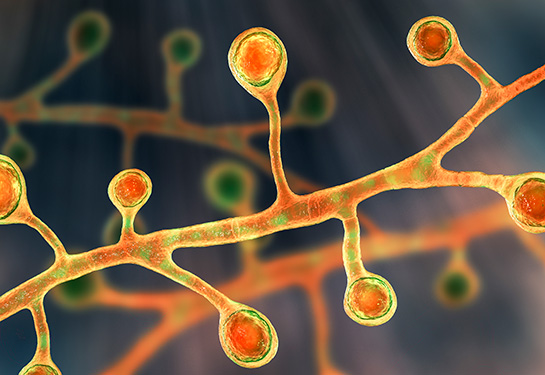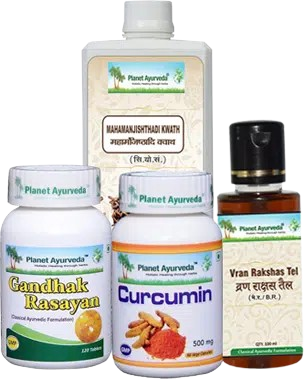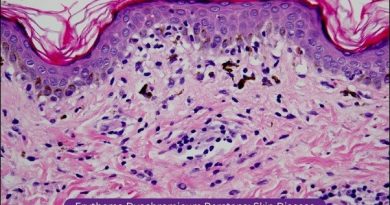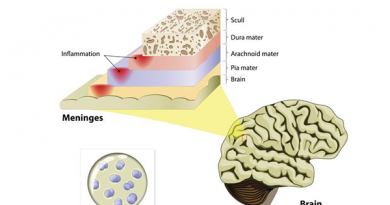Ayurvedic Treatment For Fungal Infections – Diagnosis, Symptoms & Causes
Abstract
Fungal disease refers to a group of discomforts caused by fungal infections. Mycosis is a medical term for a fungal invasion in human beings. Fungal infection may lead to the skin only or spread to tissue, bones, organs or affects the whole body. Moisture is the most favourable condition for fungus to grow. As per AYURVEDA, the term 𝘒𝘜𝘚𝘏𝘛𝘏𝘈 includes almost all the skin diseases and this is caused by the vitiation of the seven factors {3 𝘥𝘰𝘴𝘩𝘢𝘴 – 𝘝𝘢𝘵𝘢, 𝘗𝘪𝘵𝘵𝘢, 𝘒𝘢𝘱𝘩𝘢 & 4 𝘥𝘶𝘴𝘩𝘺𝘢𝘴 – 𝘙𝘢𝘬𝘵𝘢 (𝘣𝘭𝘰𝘰𝘥), 𝘙𝘢𝘴𝘢 (𝘯𝘶𝘵𝘳𝘪𝘦𝘯𝘵 𝘱𝘭𝘢𝘴𝘮𝘢), 𝘔𝘢𝘯𝘴𝘢 (𝘮𝘶𝘴𝘤𝘭𝘦𝘴) 𝘢𝘯𝘥 𝘓𝘢𝘴𝘪𝘬𝘢 (𝘭𝘺𝘮𝘱𝘩𝘢𝘵𝘪𝘤 𝘵𝘪𝘴𝘴𝘶𝘦)}.
Some of the Ayurvedic herbs and medications used for the treatment of fungal infections include, 𝘙𝘢𝘴𝘰𝘯 (garlic), 𝘈𝘥𝘳𝘢𝘬 (ginger), 𝘮𝘢𝘥𝘩𝘶𝘬(Liquorice), 𝘈𝘴𝘩𝘸𝘢𝘨𝘢𝘯𝘥𝘩𝘢 (Indian ginseng), 𝘛𝘶𝘭𝘴𝘪 (Holy basil), 𝘏𝘢𝘳𝘪𝘥𝘳𝘢 ( turmeric), 𝘝𝘢𝘴𝘢 ( Malabar nut) etc. In this article, we are going to read about fungal infections and its ayurvedic correlation as Kushtha with treatment.

Introduction
Fungal infection is limited to the dead layers of skin but is usually encouraged by damp and warm weather. The infection can be transmitted from one person to another, through soil, damp shower floors or through pet animals. It may spread from one part to another by scratching or touching. Nearly 200 million people have serious Fungal Diseases which cause a major impact on their health or life.
Causes
Common Pathogenic fungi includes 𝘈𝘴𝘱𝘦𝘳𝘨𝘪𝘭𝘭𝘶𝘴, 𝘉𝘭𝘢𝘴𝘵𝘰𝘮𝘺𝘤𝘦𝘴, 𝘊𝘢𝘯𝘥𝘪𝘥𝘢, 𝘊𝘳𝘺𝘱𝘵𝘰𝘤𝘰𝘤𝘤𝘶𝘴. They affect different parts of the body such as eyes, ears, GI Tract, vagina, mouth, throat, nails, lungs and skin.
According to Ayurveda, Kushtha is caused by:
- Virudhashan – intake of wrong food combinations like sour curd and milk together, seafood and milk together.
- Vishmashan – heavy food intake or eating speedingly.
- Adhyakshan – excessive food intake.
- Kledak Ahar – intake of oily foods and junk foods leads to increased kapha dosha.
- Newly Harvested Food
- Suppression of the urge for vomiting or other natural urges.
- Drinking cold water immediately after sun exposure or exercise.
- Doing physical exercise after taking excessive food
- Excessive intake of masha, tila, moolak, pishtanna
Symptoms
Symptoms vary from person to person. Itching, redness, irritation, blisters, flaky or cracking rashes and nail discoloration are the most common symptoms.Asthma, fatigue, headache, muscle aches, joint pain etc. In Ayurveda, there are 18 subcategories classified as 11 𝘔𝘢𝘩𝘢𝘬𝘶𝘴𝘩𝘵𝘩𝘢 (major skin diseases) and 7 𝘒𝘴𝘩𝘶𝘥𝘳𝘢 𝘒𝘶𝘴𝘩𝘵𝘢 (minor skin diseases). Another classification is 𝘋𝘢𝘥𝘳𝘶 (ringworm) and 𝘈𝘭𝘢𝘴𝘢 (athlete’s foot).
Diagnosis
- Fungal infections can be diagnosed by Inspection of the affected site.
- Microscopic examination.
- Fungal culture.
- Biopsy can be needed.
As per Ayurveda, Kushtha can be diagnosed by Trividh pareeksha (Darshan, sparshana, prashana) , Ashtavidh pareeksha (nadi, mala, mootra, jihwa, sparsh, drik, aakriti).
Treatment
- Antifungal tablets, creams, medicated ointments can be given.
- Basic hygiene should be maintained.
- Avoid sharing towels, clothes, sandals.
In 𝘈𝘠𝘜𝘙𝘝𝘌𝘋𝘈,
Panchakarma Procedures In Kushtha
𝘝𝘢𝘮𝘢𝘯𝘢 is one of the major 𝘱𝘢𝘯𝘤𝘩𝘢𝘬𝘢𝘳𝘮𝘢 procedures, in which various herbs are administered orally to induce vomiting. This procedure is done by drugs that are categorised under 𝘷𝘢𝘮𝘢𝘬 and 𝘷𝘢𝘮𝘢𝘯𝘰𝘱𝘢𝘨 𝘥𝘳𝘢𝘷𝘺𝘢𝘴 eg. 𝘮𝘢𝘥𝘢𝘯𝘢𝘱𝘩𝘢𝘭𝘢.
𝘝𝘪𝘳𝘦𝘤𝘩𝘢𝘯𝘢 is used in pitta dominant condition in kushtha. In this procedure herbs are administered to induce purgation by 𝘛𝘳𝘪𝘷𝘳𝘪𝘵, 𝘋𝘢𝘯𝘵𝘪.
𝘈𝘴𝘵𝘩𝘢𝘱𝘯𝘢 𝘣𝘢𝘴𝘵𝘪(decoction enema) can also be given by 𝘋𝘢𝘳𝘷𝘪, 𝘣𝘳𝘪𝘩𝘢𝘵𝘪.
𝘈𝘯𝘶𝘷𝘢𝘴𝘯𝘢 𝘉𝘢𝘴𝘵𝘪(fat enema) by 𝘮𝘢𝘥𝘩𝘶𝘬, 𝘯𝘪𝘮𝘣𝘢, 𝘬𝘶𝘵𝘢𝘫𝘢
𝘗𝘳𝘢𝘤𝘩𝘢𝘯𝘯 𝘙𝘢𝘬𝘵𝘮𝘰𝘬𝘴𝘩𝘢𝘯𝘢
𝘕𝘢𝘴𝘺𝘢
𝘝𝘢𝘪𝘳𝘦𝘤𝘩𝘯𝘪𝘤 𝘥𝘩𝘰𝘰𝘮𝘱𝘢𝘯𝘢
Lepas Are Topical Applications Prepared From Single Herbs Or Polyherbal Formulations.
- Chitrakadi lepa
- Mamsyadi lepa
- trapuadi lepa
- kadaladi lepa
- Kushthadi lepa
- Karveeradi lepa
- Lodhradi lepa
- Sidhamhar lepa
- Edgajadi lepa
𝘚𝘪𝘥𝘩𝘢𝘳𝘵𝘩𝘢𝘬𝘢 snana
Ayurvedic Herbs For Fungal Infections
Rasona (𝘈𝘭𝘭𝘪𝘶𝘮 𝘴𝘢𝘵𝘪𝘷𝘶𝘮) Garlic – acts as a detoxifier and has antiseptic properties that are helpful in various skin diseases.
Adraka (𝘡𝘪𝘯𝘨𝘪𝘣𝘦𝘳 𝘰𝘧𝘧𝘪𝘤𝘪𝘯𝘢𝘭𝘦) Ginger – acts as an appetizer, increases digestive fire and promotes digestion, balances vitiated Vata and lowers vitiated Kapha
Haridra (𝘊𝘶𝘳𝘤𝘶𝘮𝘢 𝘭𝘰𝘯𝘨𝘢) Turmeric –it has anti-inflammatory, antiseptic properties and acts as anti fungal
Ashwagandha (withania somnifera) Indian ginseng – It is one of the main immune booster drugs that can be used in the management of candidiasis, one of the most common infections affecting individuals with weak immunity. Also acts as an anti inflammatory and analgesic properties.
Tulsi (𝘰𝘤𝘪𝘮𝘶𝘮 𝘴𝘢𝘯𝘤𝘵𝘶𝘮) Holy Basil – Acts on the nervous, digestive and respiratory systems and has antibacterial, anti microbial, antiseptic and anti spasmodic and pain relieving properties. Tulsi also helps in increasing the digestion process by destroying Ama.
Vasa (𝘈𝘥𝘩𝘢𝘵𝘰𝘥𝘢 𝘝𝘢𝘴𝘪𝘤𝘢) Malabar nut- acts on respiratory, excretory, nervous and circulatory systems.This herb primarily acts on the respiratory system and is also very effective in treating fungal diseases. This drug efficiently works on the respiratory system .
Ayurvedic Medicines For Fungal Infection
- Mustadi Churan
- Triphaladi churan
- Mustadi churan
- Patolmuladi kshaya
- Kritmalak kwatha
- Madhvasava
- Triphalasava
- Kanakbindvarishta
Ayurvedic Tel For Fungal Infection
- Kushthadya tel
- Shwetakrveeryadya tel
- Shwetakrveerpallavadya tel
- Tiktikshwadi tel
- Kanakkshiri tel
Ayurvedic Ghrita For Fungal Infection
- Tiktashatpala ghrita
- Mahatiktak ghrita
- Mahakhadeer ghrita
Herbal Remedies By Planet Ayurveda
Planet Ayurveda is a herbal manufacturing company that provides great treatment with miraculous results for every health concerned patient. Here , formulations are made under proper guidance by MD Ayurveda Doctors and these medications are 100% natural. There are no adhesives, dyes, fillers, or adulterants used. There are no side effects of our formulations that are most effective herbal and natural. In fungal infections Planet Ayurveda gives many formulations to manage the diseases very well. These are-
- Curcumin Capsules
- Gandhak Rasayan
- Mahamanjishthadi Kwath
- Vran Rakshas Tel
Herbal Remedies For Fungal Disease


Curcumin Capsules
This is a single herbal capsule. It consists of Haridra Extract (𝘊𝘶𝘳𝘤𝘶𝘮𝘢 𝘭𝘰𝘯𝘨𝘢). Haridra improves blood circulation and blood tissue formation and acts as a natural antibiotic for the intestinal flora. Curcumin is an amazing antiseptic and in classical texts it comes under varnya (Skin complexion improving) herbs.
Dosage- 1-2 capsules twice daily with plain water, after meals.
Gandhak Rasayan
This is a single herbal capsule. Consists of Shuddha Gandhak (Sulphur).This is widely used for managing the fungal infections caused by 𝘊𝘢𝘯𝘥𝘪𝘥𝘢 𝘢𝘭𝘣𝘪𝘤𝘢𝘯𝘴 as it has antiseptic, anti-inflammatory or antihistamine properties.
Dosage- 1-2 tablets twice or thrice daily with lukewarm water.
Mahamanjishthadi Kwath
This is a detoxifying medicine that cleanses the blood. It consists of Manjistha 𝘙𝘶𝘣𝘪𝘢 𝘤𝘰𝘳𝘥𝘪𝘧𝘰𝘭𝘪𝘢, 𝘕𝘢𝘨𝘢𝘳𝘮𝘰𝘵𝘩𝘢 𝘊𝘺𝘱𝘦𝘳𝘶𝘴 𝘳𝘰𝘵𝘶𝘯𝘥𝘶𝘴, 𝘒𝘶𝘥𝘢 𝘏𝘰𝘭𝘢𝘳𝘳𝘩𝘦𝘯𝘢 𝘢𝘯𝘵𝘪𝘥𝘺𝘴𝘦𝘯𝘵𝘦𝘳𝘪𝘤𝘢 𝘦𝘵𝘤. The herbal formulation is prepared from natural extracts of many herbs that have a great impact not only on skin but also on hair.
Dosage-10-20 ml twice a day after meals with mixing in lukewarm water.
Vran Rakshas Tel
It is a herbomineral Ayurvedic classical preparation which helps in improving the infectious internal wounds . It is also an effective formulation for skin conditions. It consists of Parad (purified mercury), Gandhak (purified sulphur), Manshila (purified realgar), Sindhur (processed mercury and sulphur).
How to use- Must be applied externally over the wound area after washing and drying it well. It can be applied 3-4 times in a day.
Conclusion
Fungal Infection can affect anyone, and they can appear on several parts of the body. Different types of fungi can cause fungal infections. Fungal infections commonly develop in moist areas of the body and show symptoms like itching, flaking or cracking of skin, rashes etc. In Ayurveda it can be correlated with 𝘒𝘶𝘴𝘩𝘵𝘩𝘢. Kushtha is widely classified in 18 subcategories, these management begins by purification processes like 𝘝𝘢𝘮𝘢𝘯, 𝘝𝘪𝘳𝘦𝘤𝘩𝘢𝘯𝘢, 𝘙𝘢𝘬𝘵𝘢𝘮𝘰𝘬𝘴𝘩𝘢𝘯𝘢 and 𝘈𝘩𝘢𝘳 – 𝘷𝘪𝘩𝘢𝘳 regimens. Medications include topical as well as internal administrations. In case of any queries you can contact www.planetayurveda.com.




